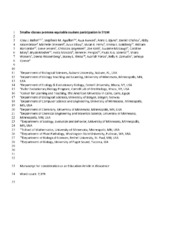Smaller classes promote equitable student participation in STEM
Ballen, Cissy J.; Aguillon, Stepfanie M.; Awwad, Azza; Bjune, Anne Elisabeth; Challou, Daniel; Drake, Abby Grace; Driessen, Michelle; Ellozy, Aziza; Ferry, Vivian E.; Goldberg, Emma E.; Harcombe, William; Jensen, Steve; Jørgensen, Christian; Koth, Zoe; McGaugh, Suzanne; Mitry, Caroline; Mosher, Bryan; Mostafa, Hoda; Petipas, Renee H.; Soneral, Paula A.G.; Watters, Shana; Wassenberg, Deena; Weiss, Stacey L.; Yonas, Azariah; Zamudio, Kelly R.; Cotner, Sehoya Harris
Peer reviewed, Journal article
Accepted version
Permanent lenke
http://hdl.handle.net/1956/22078Utgivelsesdato
2019Metadata
Vis full innførselSamlinger
Sammendrag
As science, technology, engineering, and mathematics (STEM) classrooms in higher education transition from lecturing to active learning, the frequency of student interactions in class increases. Previous research documents a gender bias in participation, with women participating less than would be expected on the basis of their numeric proportions. In the present study, we asked which attributes of the learning environment contribute to decreased female participation: the abundance of in-class interactions, the diversity of interactions, the proportion of women in class, the instructor's gender, the class size, and whether the course targeted lower division (first and second year) or upper division (third or fourth year) students. We calculated likelihood ratios of female participation from over 5300 student–instructor interactions observed across multiple institutions. We falsified several alternative hypotheses and demonstrate that increasing class size has the largest negative effect. We also found that when the instructors used a diverse range of teaching strategies, the women were more likely to participate after small-group discussions.
